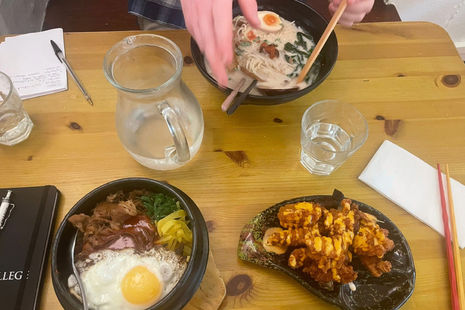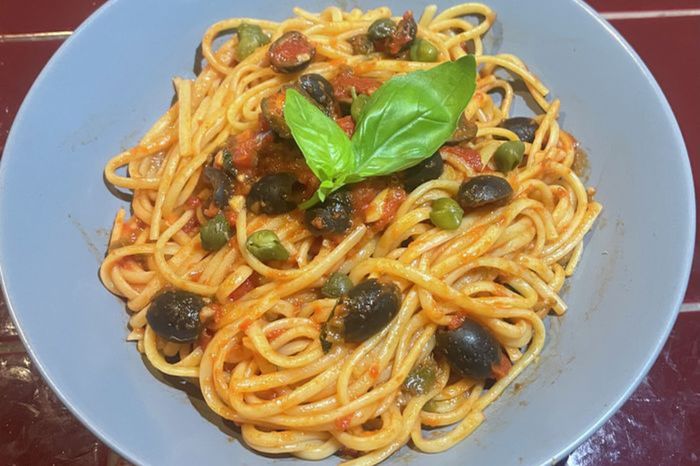Table for two: Ittou Noodle Bar
Ed and Finn deliver their first restaurant column to discover what Ittou Noodle Bar has been cooking up

Far beneath the madding crowd of King’s Parade is a charming cubbyhole. With its entrance like a vertical matchbox, Ittou Noodle Bar is easy to miss, and, despite being students at King’s directly opposite, Ed and I both took over a year to give it a second look: perhaps the lamppost out front obscured it from view. With this in mind, it seems to be a shoo-in for the now-cliched status of ’hidden gem’, but with queuing to get a table commonplace, its existence should be considered an open secret at most. Indeed, Ittou has built up something of a cult-status in the Cambridge food scene, delivering delicious East Asian cuisine. Its opening times of 12-8pm make it unsuitable for a late-night dining spot, so we arrived bright and early at 6pm on a Friday night.
As the initially daunting queue was whittled down due to an impressively efficient turnover of tables, we were shown from the stairwell past the open kitchen into one of two main dining areas. The walls in Ittou are adorned with Japanese art, as well as a curious abundance of mirrors, which we had somehow not noticed on any previous visits (seriously, 50% of the wall of the main dining area are reflections of the other). Even if this house of mirrors style decor creates an impression of size, from the phonebox sized stairwell to the cloistered dining area, space is not a luxury that Ittou boasts much of. However, the cosiness is central to its unique charm. This is complemented by its service: direct and efficient, with a casual politeness that puts you at ease. Where so many restaurants paradoxically clamour to feel rustic and relaxed, Ittou thrives in being unpretentiously and unconsciously so. It was therefore no wonder that half the people there seemed to be on dates.
“Space is not a luxury that Ittou boasts”
With the initial intangibles a success, the most important thing remained: the food. Its menu shows a wide East Asian influence, offering dishes that are predominantly Japanese, with Korean and Thai influences. Though, it also has as an unfortunately Western disclaimer: ‘NO ADDED MSG’. MSG (monosodium glutamate) has enjoyed somewhat of a boom in popularity this decade – pushing back against outdated myths surrounding its effects – and is prevalent in East Asian cuisine. That Ittou explicitly states the lack of ‘added’ (note that many ingredients used by the restaurant likely already include natural MSG or some form of it added) appears a little unusual.
We ordered three things: Pork Tonkotsu Ramen and Beef Bibimbap for mains, with Tori Karaage on the side – all of which arrived together and were happily passed back and forth between us.
“Simple ingredients, executed to a high standard”
First off, one of Ittou’s most-renowned dishes – their pork tonkotsu ramen. Chashu pork sat in a bath of a creamy pork broth, filled with egg noodles and a soy-sauce marinated ramen egg. The dish was as dreamy as it sounds. As ramen goes, Tonkotsu is not packed full of aromatics, and therefore allows the delivery of a flavour of singular clarity and richness, derived from the slow boiling of pork bones. This is compounded by a silky finish that coats the mouth, leaving the intense richness of the pork to linger. This specific mouthfeel is one you can predict on first sight of the broth. The little bubbles present on the surface of any broth involving the boiling of bones are the emulsified products of the breakdown of collagen. The chashu pork itself was a delight and was healthy in portion-size. The chefs at Ittou have perfected the art of chashu – the pork is able to maintain its structure when picked up by chopsticks but simultaneously surrenders itself to dissolution when eaten. Lastly, the noodles themselves were more than just a vessel for the broth’s flavour. They had a welcome bite to them, a lovely textural supplement to the tenderness of the rest of the dish.
Dish score = 9
Beef Bibimbap is a traditional Korean dish: a blend of sticky rice, beef, vegetables and a chilli sauce – all topped with a runny fried egg. Simple ingredients, executed to a high standard. The beef was the star of this dish. Perfectly velveted and thinly sliced, it melted on the tongue, and carried a balance of spice, salt, and tanginess from the gochujang marinade. However, we would have preferred there to be more of it on the plate. The hot clay pot bowls the Bibimbap was served in resulted in a lovely crisp to the bottom layer of rice and added a nuttiness to the dish. Another minor criticism we had were the vegetable accompaniments: kimchi, picked cucumber, and carrot. Whilst tasty on their own, the dish as a whole would have benefitted with a more intense acidity from these to cut through the heat and salt of the gochujang-based chilli sauce.
“Condiments should always balance a dish, rather than simply add flavour”
Dish score = 7.5
On the side, the Tori Karaage – a form of Japanese fried chicken. Using chicken thigh rather than breast, Ittou achieves a real depth of flavour in this dish. The meat had clearly been marinated and brined before being coated and double-fried. The chicken itself was deliciously seasoned, with the longed-for salt and umami flavour delivered in spades by soy sauce in the marinade. The starch in the coating crisped up nicely, although by the end of the meal, the crunch had started to fade. The chicken was served with a spiced mayonnaise – the perfect condiment accompaniment. The mayo’s light heat cleanly cut through the chicken’s richness. Condiments should always balance a dish, rather than simply add flavour, and this was a perfect example.
Dish score = 8
Overall scores:
Atmosphere = 9
Food = 8.5
Value = 7
In conclusion, a visit to Ittou is harmonious from start to finish. There is complete congruence between the lowkey service, tasteful decor, and hearty, flavoursome food. Your socks are unlikely to be blown off, but in Cambridge, that is sometimes the last thing you need.
 News / Caius mourns its tree-mendous loss23 December 2025
News / Caius mourns its tree-mendous loss23 December 2025 News / Clare Hall spent over £500k opposing busway 24 December 2025
News / Clare Hall spent over £500k opposing busway 24 December 2025 Comment / Yes, I’m brown – but I have more important things to say22 December 2025
Comment / Yes, I’m brown – but I have more important things to say22 December 2025 Comment / The ‘class’ of Cambridge24 December 2025
Comment / The ‘class’ of Cambridge24 December 2025 Interviews / Politics, your own way: Tilly Middlehurst on speaking out21 December 2025
Interviews / Politics, your own way: Tilly Middlehurst on speaking out21 December 2025








